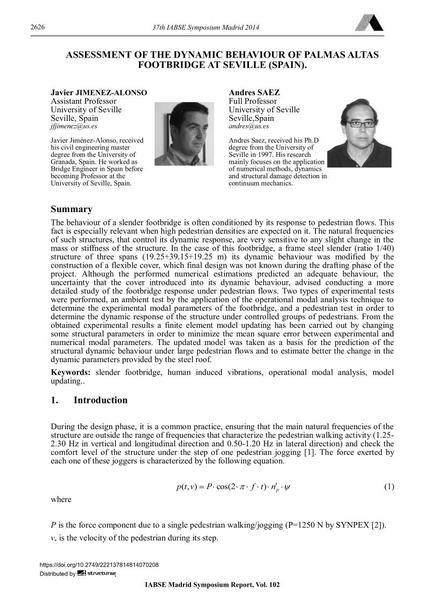Assessment of the Dynamic Behaviour of Palmas Altas Footbridge at Seville (Spain)

|
|
|||||||||||
Bibliografische Angaben
| Autor(en): |
Javier Jimenez-Alonso
Andrés Sáez |
||||
|---|---|---|---|---|---|
| Medium: | Tagungsbeitrag | ||||
| Sprache(n): | Englisch | ||||
| Tagung: | IABSE Symposium: Engineering for Progress, Nature and People, Madrid, Spain, 3-5 September 2014 | ||||
| Veröffentlicht in: | IABSE Symposium Madrid 2014 | ||||
|
|||||
| Seite(n): | 2626-2633 | ||||
| Anzahl der Seiten (im PDF): | 8 | ||||
| Jahr: | 2014 | ||||
| DOI: | 10.2749/222137814814070208 | ||||
| Abstrakt: |
The behaviour of a slender footbridge is often conditioned by its response to pedestrian flows. This fact is especially relevant when high pedestrian densities are expected on it. The natural frequencies of such structures, that control its dynamic response, are very sensitive to any slight change in the mass or stiffness of the structure. In the case of this footbridge, a frame steel slender (ratio 1/40) structure of three spans (19.25+39.15+19.25 m) its dynamic behaviour was modified by the construction of a flexible cover, which final design was not known during the drafting phase of the project. Although the performed numerical estimations predicted an adequate behaviour, the uncertainty that the cover introduced into its dynamic behaviour, advised conducting a more detailed study of the footbridge response under pedestrian flows. Two types of experimental tests were performed, an ambient test by the application of the operational modal analysis technique to determine the experimental modal parameters of the footbridge, and a pedestrian test in order to determine the dynamic response of the structure under controlled groups of pedestrians. From the obtained experimental results a finite element model updating has been carried out by changing some structural parameters in order to minimize the mean square error between experimental and numerical modal parameters. The updated model was taken as a basis for the prediction of the structural dynamic behaviour under large pedestrian flows and to estimate better the change in the dynamic parameters provided by the steel roof. |
||||
